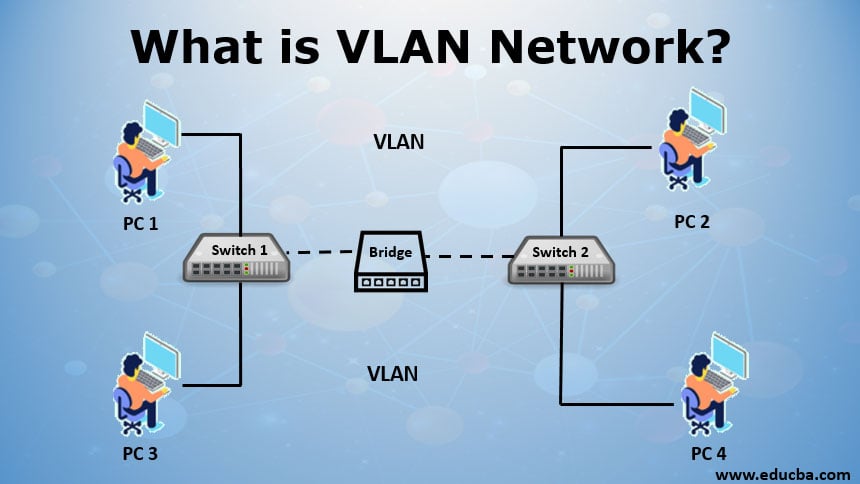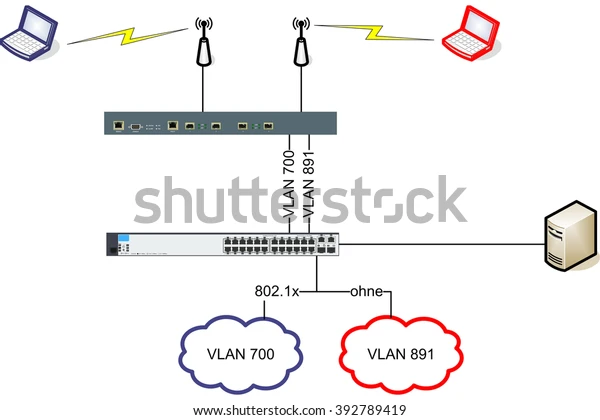
VLAN stands for virtual local area network. A local area network (LAN) is a group of network components that shares the same physical network. A VLAN is a subnetwork that virtually connects network components of different LANs into a single network, thus circumventing the physical limitations of a LAN environment. With increasing network complexities that exceed the capacity of normal LANs, VLAN has become an alternative that makes networks flexible, scalable, secure, and fast.

There are three basic types of commonly used VLANs:

VLANs divide a single physical LAN into multiple logical network segments. These logical network segments then communicate with each other as if they were made up of a single LAN when in reality they exist in one or more LANs. The network segments are separated from the rest of the physical LAN using a router, switch, or bridge. Hence, when a network node broadcasts data, it reaches other nodes of a VLAN but not on the other segments of the physical LAN.
When a LAN bridge receives data from a network node, the data is tagged either explicitly or implicitly. Explicit tagging occurs when a VLAN identifier is attached to the data so that it becomes easier for the bridge to determine the next node for the data. Implicit tagging occurs by utilizing the information present in the data (for instance the port on which the data arrived). Based on the implicit or explicit tagging, the bridge determines where the data needs to be routed to, sends the data to the next node, and hence isolates the particular LAN segment from the rest of the LAN.

VLANs simplify the complexities that are inherent in physical LANs. In a simple physical LAN, when two nodes send traffic at the same time, the data is not transmitted to the destination properly because of collision. This collision renders the entire LAN busy, and the original data has to be sent again. VLANs on the other hand transmit data from one segment to another using a switch or bridge, reducing the chances of collisions and instead of broadcasting the data to all connected network devices. Apart from this, there are other benefits of using a VLAN:
VLAN’s communicate through switches and do not require routers unless they are sending data outside the VLAN. Hence, VLANs can manage additional data load, decrease data latency, and ultimately reduce costs.
VLANs can be port-based, protocol bases or subnet-based, making it a flexible networking arrangement that can be configured between different buildings or different floors regardless of the proximity to other network nodes.
VLANs also free up network administrator's time as they divide workstations into different LAN segments. Administrators do not need to reconfigure the network when moving their workstations, and can also limit access to users because of the isolation to different LAN segments.
Large companies generally deploy a Wide Area Network (WAN) to accommodate the needs of their expansive offices and huge teams. Having multiple VLANs as an alternative can allow ease of configuration, allow cross-functional work, and facilitate data sharing between different departments of the company.
VLANs can also be used to give guest users access to wireless internet, without even accessing the core organizational network.
Critical traffic can be given more priority over the rest of the network by using and deploying VLAN-based policies.
VLANs can also be used to create a logically separate layer for VoIP. This separates the voice network from the other networks, hence the voice network typically does not touch the traffic of the underlying network and can be transmitted from one node to another unaltered.
There are a huge number of perceived benefits of using VLANs. Foxpass is a solution that allows you to reap the benefits of VLAN in conjunction with different user access management tools offered by Foxpass.
Foxpass is an out-of-the-box, server, and network automation tool that reduces the chances of security breaches by protecting the most sensitive parts of your infrastructure. Foxpass is both scalable and fault-tolerant.
You can easily integrate VLAN via RADIUS attributes using Foxpass. You can also configure Cisco switches with wireless 802.1x VLAN assignment using the easy-to-use interface of Foxpass, making it easier for you to reap the benefits of using VLAN with proper access management tools like RADIUS. With the security benefits offered by VLAN environments and the security features offered by Foxpass, you are sure to have a hardened security infrastructure that keeps security breaches at bay.
Use your G Suite or Office 365 account, or sign up with your email address.
(Have an account already? Click here to log in.)
By signing up, you agree to our terms of use and privacy policy.